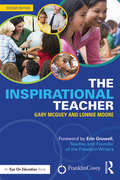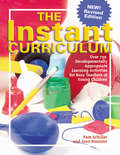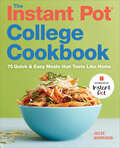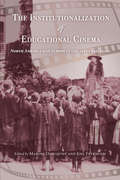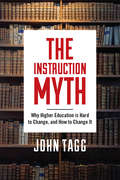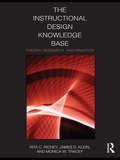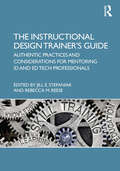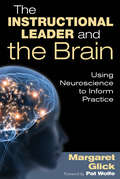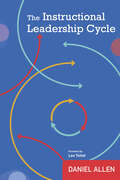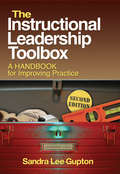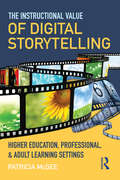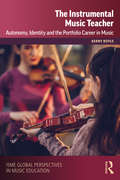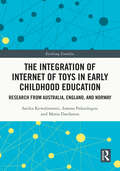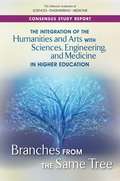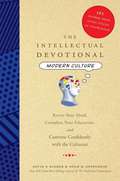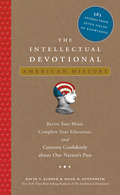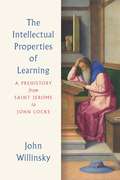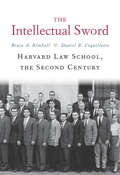- Table View
- List View
The Inspirational Teacher
by Gary McGuey Lonnie MooreBecome a teacher who truly inspires students to learn and grow! This bestselling book—from Routledge and Franklin Covey, the company that brought you The 7 Habits of Highly Effective People—is filled with practical and heartfelt advice that will resonate with teachers at all stages of their careers. The book will guide you through a simple four step process to building high-trust relationships and unleashing the greatness within all students. This timely new edition includes updated references and inspirational quotes throughout, as well as chapter reflection questions to help you make the most of what you read. In addition, several of the questionnaires and reflection tools from the book are also available on our website as free eResources, so that you can easily print and use them in your own classroom. http://www.routledge.com/books/details/9781138906242.
The Instant Curriculum, Revised: Over 750 Developmentally Appropriate Learning Activities for Busy Teachers of Young Children
by Pam Schiller Joan RossanoThe Instant Curriculum is a resource for teachers who create and implement comprehensive early childhood programs. The new and revised edition of this book contains many brand new activities. Activities are designed to encourage the development of skills and practice specific concepts. This book reduces both the amount of time teachers spend in preparation, and the amount of money spent for purchasing supplies. The chapters in this book represent the primary domains included in a comprehensive early childhood curriculum. Each chapter begins with an overview providing the basic philosophy behind that particular curriculum area. This book will be an essential tool for new teachers, and a useful resource for teachers who may have the first edition of The Instant Curriculum. Special features of this book: The focus on concepts and skills provides a flexible format that allows teachers to select activities that strengthen a specific skill for one or many children. Teachers can customize an activity to match curriculum themes. For example, the "Pasting Sets" activity in the Math chapter can be changed from pasting circles and squares to pasting sets of cats and dogs for an Animal theme Activities are assigned to a specific area, but are not limited to that area. For example, to develop the concept of four (Math curriculum area), a teacher using an integrated approach will provide opportunities to clap-count four (Music & Movement), to collect four leaves on a nature walk (Science) or to use four colors on a collage (Art). Activities for Teachable Moments are interspersed throughout the book. Special sections on Transitions and Family Connections are included. A chapter on problem solving and critical thinking focuses on the potential application of these skills to all areas of learning and life. Chapters on literacy and math are in sub-divided into skill areas. In both cases, activities move in a developmental continuum that, if used in order, allows children to build from easier skills to more complex skills. Teachers will be able to use these activities to meet literacy, language, and math expectations. The Instant Curriculum emphasizes allowing children to learn at their own level of development and progress accordingly. The book also encourages teachers to provide choices for children to make and to allow children to experiment and discover. In this way, young children will develop skills in independent learning and will feel confident in their ability. Learning will become an interesting process that continues for a lifetime. About the authors Pam Schiller's career spans nearly every facet of the early childhood profession. Pam has authored or co-authored over 30 books on topics ranging from curriculum development to the management of childcare centers to the use of current brain research in the classroom. Pam has authored numerous articles for early childhood journals, including Child Care Information Exchange and Texas Child Care Quarterly. She is a highly sought-after speaker and has given numerous presentations over the years for well-known organizations such as NAEYC, SECA, Association for Childhood Education International, and International Reading Association. Joan Rossano has been a co-owner of a private preschool, and director of several childcare centers. Working with fellow educators, Joan formed the professional association, Gulf Coast Association for the Education of Young Children, which continues to provide professional development for preschool educators in the area. During this time, Pam Schiller and Joan Rossano wrote a number of articles and pamphlets on preschool issues and program development. Joan twice served as president of the Gulf Coast Association for the Education of Young Children.
The Instant Pot® College Cookbook: 75 Quick and Easy Meals that Taste Like Home
by Julee MorrisonThe Instant Pot® College Cookbook is the definitive dorm room solution for easy, homemade meals. Cereal and pizza might be enough to sustain a crash study session, but the best brain food is a homemade meal. The Instant Pot® College Cookbook saves college students from four years of nutrient deprivation with quick and easy, budget-friendly meals. From grab-n-go Breakfast Burritos to late night Macaroni and Cheese, this college cookbook contains 75 tasty meals that require no previous cooking or Instant Pot® experience to whip up. Using easy-to-find and affordable ingredients, The Instant Pot® College Cookbook saves students time and money too with good fast food that rivals any take-out menu. The Instant Pot® College Cookbook includes: Instant Pot® cooking 101 that explains pressure cooker settings for every type of food, tips, and FAQ. 75 home-style meals that include breakfast, everyday staples, soups and stews, meatless meals, poultry, pork and beef, dessert, and more! Fool-proof recipes that combine quick prep times with easy-to-find and affordable ingredients to suit student schedules and wallets. Save ramen for emergencies with quick and easy recipes from The Instant Pot® College Cookbook.
The Institutionalization of Educational Cinema: North America and Europe in the 1910s and 1920s
by Marina Dahlquist and Joel FrykholmEssays by scholars on how film has been used by schools, libraries, governments, and organizations for educational purposes.The potential of films to educate has been crucial for the development of cinema intended to influence culture, and is as important as conceptions of film as a form of art, science, industry, or entertainment. Using the concept of institutionalization as a heuristic for generating new approaches to the history of educational cinema, contributors to this volume study the co-evolving discourses, cultural practices, technical standards, and institutional frameworks that transformed educational cinema from a convincing idea into an enduring genre. The Institutionalization of Educational Cinema examines the methods of production, distribution, and exhibition established for the use of educational films within institutions—such as schools, libraries, and industrial settings—in various national and international contexts and takes a close look at the networks of organizations, individuals, and government agencies that were created as a result of these films’ circulation. Through case studies of educational cinemas in different North American and European countries that explore various modes of institutionalization of educational film, this book highlights the wide range of vested interests that framed the birth of educational and nontheatrical cinema.
The Institutionalization of Educational Cinema: North America and Europe in the 1910s and 1920s
by Marina Dahlquist and Joel FrykholmEssays by scholars on how film has been used by schools, libraries, governments, and organizations for educational purposes.The potential of films to educate has been crucial for the development of cinema intended to influence culture, and is as important as conceptions of film as a form of art, science, industry, or entertainment. Using the concept of institutionalization as a heuristic for generating new approaches to the history of educational cinema, contributors to this volume study the co-evolving discourses, cultural practices, technical standards, and institutional frameworks that transformed educational cinema from a convincing idea into an enduring genre. The Institutionalization of Educational Cinema examines the methods of production, distribution, and exhibition established for the use of educational films within institutions—such as schools, libraries, and industrial settings—in various national and international contexts and takes a close look at the networks of organizations, individuals, and government agencies that were created as a result of these films’ circulation. Through case studies of educational cinemas in different North American and European countries that explore various modes of institutionalization of educational film, this book highlights the wide range of vested interests that framed the birth of educational and nontheatrical cinema.
The Instruction Myth: Why Higher Education is Hard to Change, and How to Change It
by John TaggHigher education is broken, and we haven’t been able to fix it. Even in the face of great and growing dysfunction, it seems resistant to fundamental change. At this point, can anything be done to save it? The Instruction Myth argues that yes, higher education can be reformed and reinvigorated, but it will not be an easy process. In fact, it will require universities to abandon their central operating principle, the belief that education revolves around instruction, easily measurable in course syllabi, credits, and enrollments. Acclaimed education scholar John Tagg presents a powerful case that instruction alone is worthless and that universities should instead be centered upon student learning, which is far harder to quantify and standardize. Yet, as he shows, decades of research have indicated how to best promote student learning, but few universities have systematically implemented these suggestions. This book demonstrates why higher education must undergo radical change if it hopes to survive. More importantly, it offers specific policy suggestions for how universities can break their harmful dependence on the instruction myth. In this extensively researched book, Tagg offers a compelling diagnosis of what’s ailing American higher education and a prescription for how it might still heal itself.
The Instructional Design Knowledge Base
by Rita C. Richey James D. Klein Monica W. TraceyThe Instructional Design Knowledge Base: Theory, Research and Practice provides ID professionals and students at all levels with a comprehensive exploration of the theories and research that serve as a foundation for current and emerging ID practice. This book offers both current and classic interpretations of theory from a range of disciplines and approaches. It encompasses general systems, communication, learning, early instructional, media, conditions-based, constructivist design and performance-improvement theories. Features include: rich representations of the ID literature concise theory summaries specific examples of how theory is applied to practice recommendations for future research a glossary of related terms a comprehensive list of references. A perfect resource for instructional design and technology doctoral, masters and educational specialist certificate programs, The Instructional Design Knowledge Base provides students and scholars with a comprehensive background for ID practice and a foundation for future ID thinking.
The Instructional Design Trainer’s Guide: Authentic Practices and Considerations for Mentoring ID and Ed Tech Professionals
by Jill E. Stefaniak Rebecca M. ReeseThe Instructional Design Trainer’s Guide provides foundational concepts and actionable strategies for training and mentoring instructional design and educational technology students to be effective across contexts. ID faculty are charged with bridging the gap between research and practice preparing graduate students for the real-world workforce. This book provides trainers and university programs with authentic learning experiences that better articulate the practices of and demands on design and technology professionals in the field. Through this enhanced perspective, learners will be better positioned to confidently embrace constraints, work among changing project expectations, interact with multiple stakeholders, and convey to employers the skills and competencies gleaned from their formal preparation.
The Instructional Design Trainer’s Guide: Authentic Practices and Considerations for Mentoring ID and Ed Tech Professionals
by Jill E. Stefaniak Rebecca M. ReeseThe Instructional Design Trainer’s Guide provides foundational concepts and actionable strategies for training and mentoring instructional design and educational technology students to be effective across contexts. ID faculty are charged with bridging the gap between research and practice preparing graduate students for the real-world workforce. This book provides trainers and university programs with authentic learning experiences that better articulate the practices of and demands on design and technology professionals in the field. Through this enhanced perspective, learners will be better positioned to confidently embrace constraints, work among changing project expectations, interact with multiple stakeholders, and convey to employers the skills and competencies gleaned from their formal preparation.
The Instructional Leader and the Brain: Using Neuroscience to Inform Practice
by Margaret C. GlickApply neuroscience to leadership and become a gamechanger An instructional leader who understands how people learn has the power to transform a school and raise student achievement. Brain pioneer Margaret Glick weaves the fields of cognitive science, educational leadership, and instruction into a cohesive framework for understanding the benefits of how the brain learns: Increased understanding of the learning process Improved communication Enhanced relationships Better interpersonal skills New tools for giving effective feedback An inner compass for continuous improvement Included are brain illustrations, rubrics, implementation ideas for teachers, step-by-step pedagogy, and assessments.
The Instructional Leadership Cycle
by Daniel AllenThe Instructional Leadership Cycle introduces a multifaceted model for continuous school and system improvement, founded on an adaptable set of professional practices for K–12 leaders.Daniel Allen draws on a breadth of education system experience, spanning from classroom to top office, to outline a flexible framework—the Instructional Leadership Cycle—that supports school leaders in advancing equitable, high-quality instruction. In this comprehensive and deeply practical work, Allen mentors leaders through the framework&’s cycles of implementation, analysis, reflection, and improvement, which are anchored in the rhythms of the annual school calendar.As Allen counsels readers on the application of the Instructional Leadership Cycle, he also explains the genesis of the framework, which has been successfully implemented in more than sixty California schools, resulting in dramatic annual student achievement gains. With ample real-world examples, Allen demonstrates how leaders can move beyond strategic planning to fulfill the promise of organizational change. Incorporating elements of universal design for learning, multi-tiered systems of support, and key performance indicators, Allen&’s approach encourages leaders to develop an instructional vision for their institution and then set it in motion. The work shows how the process circles back to a few key tenets: ensure that all educators have access to a common set of tools to use in support of instructional improvement, effectively measure progress with school data analysis, and leverage organizational learning.This clear-sighted work guides equity-focused school leaders to reliably bring about instructional transformation, moving toward positive learning outcomes for all students.
The Instructional Leadership Toolbox: A Handbook for Improving Practice
by Sandra Lee Gupton"I applaud Gupton′s focus on the learner. This is the most important tenet for a school administrator′s decision making. Each chapter describes a portion of school leadership that the successful principal needs to master."—Sharon Madsen Redfern, PrincipalHighland Park Elementary School, Lewistown, MTUse these powerful leadership tools to build teamwork and improve instruction!Every school leader needs a toolbox of strategies for improving teaching and learning schoolwide. In this second edition of The Instructional Leadership Toolbox, Sandra Lee Gupton examines the role of principals in leading instruction and provides practical ways for leaders to reflect on and improve their practice. Emphasizing a democratic approach that involves stakeholders in instructional leadership, this resource offers a compendium of helpful skills and strategies drawn from current research and theory in school administration. The book provides:Updated standards from NAESP and ISLLCNew research that shows how a principal′s actions can affect student achievementQuestions for reflective practiceQuotes and examples of instructional leadership strategies by practicing principals and veteran educatorsAdditional resources such as Web sites, workbooks, books, and articlesThis valuable guide provides a blueprint that demonstrates how school leaders can focus on student learning, while using specific tools to empower others and build teams for a common goal: increased student achievement.
The Instructional Value of Digital Storytelling: Higher Education, Professional, and Adult Learning Settings
by Patricia McGeeAlthough storytelling has been recognized as an effective instructional strategy for some time, most educators are not informed about how to communicate a story that supports learning—particularly when using digital media. The Instructional Value of Digital Storytelling provides a broad overview of the concepts and traditions of storytelling and prepares professors, workplace trainers, and instructional designers to tell stories through 21st century media platforms, providing the skills critical to communication, lifelong learning, and professional success. Using clear and concise language, The Instructional Value of Digital Storytelling explains how and why storytelling can be used as a contemporary instructional method, particularly through social media, mobile technologies, and knowledge-based systems. Examples from different sectors and disciplines illustrate how and why effective digital stories are designed with learning theory in mind. Applications of storytelling in context are provided for diverse settings within higher education as well as both formal and informal adult learning contexts.
The Instrumental Music Teacher: Autonomy, Identity and the Portfolio Career in Music (ISME Series in Music Education)
by Kerry Boyle International Society for Music Education (ISME)Instrumental teaching in the UK is characterised by a lack of regulation and curriculum, whereby individuals can teach with no training or qualification. Kerry Boyle explores the way in which individuals who begin teaching can negotiate successful careers in music without formal training. Existing studies suggest that individuals in this context have complex understandings of professional identity, preferring to identify as musicians or performers rather than teachers, even when most of their income is derived from teaching. Boyle explores the complex working lives of instrumental teachers in the UK, including routes into instrumental teaching and the specific meanings associated with the role and identity of the professional musician for individuals involved in portfolio careers in music. Through an examination of the lived experience of instrumental teachers, this study highlights the need to revise existing notions of the professional musician to acknowledge contemporary careers in music. The resulting insights can be used to inform and enhance existing approaches to careers in music and contribute to career preparation in undergraduate music students.
The Instrumental University: Education in Service of the National Agenda after World War II (Histories of American Education)
by Ethan SchrumIn The Instrumental University, Ethan Schrum provides an illuminating genealogy of the educational environment in which administrators, professors, and students live and work today. After World War II, research universities in the United States underwent a profound mission change. The Instrumental University combines intellectual, institutional, and political history to reinterpret postwar American life through the changes in higher education. Acknowledging but rejecting the prevailing conception of the Cold War university largely dedicated to supporting national security, Schrum provides a more complete and contextualized account of the American research university between 1945 and 1970. Uncovering a pervasive instrumental understanding of higher education during that era, The Instrumental University shows that universities framed their mission around solving social problems and promoting economic development as central institutions in what would soon be called the knowledge economy. In so doing, these institutions took on more capitalistic and managerial tendencies and, as a result, marginalized founding ideals, such as pursuit of knowledge in academic disciplines and freedom of individual investigators.The technocratic turn eroded some practices that made the American university special. Yet, as Schrum suggests, the instrumental university was not yet the neoliberal university of the 1970s and onwards in which market considerations trumped all others. University of California president Clark Kerr and other innovators in higher education were driven by a progressive impulse that drew on an earlier tradition grounded in a concern for the common good and social welfare.
The Integration of Internet of Toys in Early Childhood Education: Research from Australia, England, and Norway (Evolving Families)
by Ioanna Palaiologou Sarika Kewalramani Maria DardanouThis book offers a fresh look at recent developments in policy, curricula and pedagogical discourse around children’s play with Internet of Toys (IoToys). By expanding the notion of digital and smart play perspectives in early childhood education, the authors critique and develop the broader subject area of IoToys play to better serve its end users. The book brings together research from across three different countries: Australia, Norway and England. It offers tangible examples of how one can use IoToys to build children’s social skills, emotional intelligence, sense of achievement, collaboration and aspects of STEM and design play thinking processes. The learning stories of children’s IoToys play will deliver a comprehensive review of how practitioners and parents can come together to build communities of practice for (re)enhancing children’s learning and growth using evolving technology-based play and engage in paradigmatic debates. Readers as a result will better appreciate the growth in pragmatic applications of technologies together with theoretical perspectives. The book will be a valuable resource for any academic or practitioner just beginning to understand the complexities and success stories of integrating IoToys for children’s playful learning.
The Integration of Psychology and Christianity: A Domain-Based Approach (Christian Association for Psychological Studies Books)
by Mark A. Yarhouse William L. Hathawayworldview integrationtheoretical integrationapplied integrationrole integrationpersonal integration
The Integration of the Humanities and Arts with Sciences, Engineering, and Medicine in Higher Education: Branches From The Same Tree
by Engineering Medicine National Academies of SciencesIn the United States, broad study in an array of different disciplines —arts, humanities, science, mathematics, engineering— as well as an in-depth study within a special area of interest, have been defining characteristics of a higher education. But over time, in-depth study in a major discipline has come to dominate the curricula at many institutions. This evolution of the curriculum has been driven, in part, by increasing specialization in the academic disciplines. There is little doubt that disciplinary specialization has helped produce many of the achievement of the past century. Researchers in all academic disciplines have been able to delve more deeply into their areas of expertise, grappling with ever more specialized and fundamental problems. Yet today, many leaders, scholars, parents, and students are asking whether higher education has moved too far from its integrative tradition towards an approach heavily rooted in disciplinary “silos”. These “silos” represent what many see as an artificial separation of academic disciplines. This study reflects a growing concern that the approach to higher education that favors disciplinary specialization is poorly calibrated to the challenges and opportunities of our time. The Integration of the Humanities and Arts with Sciences, Engineering, and Medicine in Higher Education examines the evidence behind the assertion that educational programs that mutually integrate learning experiences in the humanities and arts with science, technology, engineering, mathematics, and medicine (STEMM) lead to improved educational and career outcomes for undergraduate and graduate students. It explores evidence regarding the value of integrating more STEMM curricula and labs into the academic programs of students majoring in the humanities and arts and evidence regarding the value of integrating curricula and experiences in the arts and humanities into college and university STEMM education programs.
The Intellective Space: Thinking beyond Cognition
by Laurent DubreuilThe Intellective Space explores the nature and limits of thought. It celebrates the poetic virtues of language and the creative imperfections of our animal minds while pleading for a renewal of the humanities that is grounded in a study of the sciences.
The Intellectual Devotional, Modern Culture: Revive Your Mind, Complete Your Education, and Converse Confidently with the Culturati
by David S. Kidder Noah D. OppenheimThe latest entry in The Intellectual Devotional series dives into the complex and vital world of Western culture, covering the essential artists, works, icons, and consumer products that have defined the way individuals live and express themselves.
The Intellectual Devotional: Revive Your Mind, Complete Your Education, and Converse Confidently about Our Na tion's Past (The Intellectual Devotional Series)
by David S. Kidder Noah D. OppenheimModeled after those bedside books of prayer and contemplation that millions turn to for daily spiritual guidance and growth, the national bestseller The Intellectual Devotional—offering secular wisdom and cerebral nourishment—drew a year's worth of readings from seven different fields of knowledge. <P><P>In The Intellectual Devotional: American History, authors David S. Kidder and Noah D. Oppenheim have turned to the rich legacy of American history for their selections. <P>From Thomas Jefferson and Benjamin Franklin to Martin Luther King Jr., from the Federalist Papers to Watergate, the giant figures, cultural touchstones, and pivotal events in our national heritage provide a bountiful source of reflection and education that will refresh knowledge, revitalize the mind, and open new horizons of intellectual discovery.
The Intellectual Life of Colonial New England
by Samuel Eliot MorisonDescribes the thought of New England's scholars during the period.
The Intellectual Lives of Children
by Susan EngelA look inside the minds of young children shows how we can better nurture their abilities to think and grow.Adults easily recognize children’s imagination at work as they play. Yet most of us know little about what really goes on inside their heads as they encounter the problems and complexities of the world around them. In The Intellectual Lives of Children, Susan Engel brings together an extraordinary body of research to explain how toddlers, preschoolers, and elementary-aged children think. By understanding the science behind how children observe their world, explain new phenomena, and solve problems, parents and teachers will be better equipped to guide the next generation to become perceptive and insightful thinkers.The activities that engross kids can seem frivolous, but they can teach us a great deal about cognitive development. A young girl’s bug collection reveals important lessons about how children ask questions and organize information. Watching a young boy scoop mud can illuminate the process of invention. When a child ponders the mystery of death, we witness how children build ideas. But adults shouldn’t just stand around watching. When parents are creative, it can rub off on their children. Engel shows how parents and teachers can stimulate children’s curiosity by presenting them with mysteries to solve.Unfortunately, in our homes and schools, we too often train children to behave rather than nurture their rich and active minds. This focus is misguided, since it is with their first inquiries and inventions—and the adult world’s response to them—that children lay the foundation for a lifetime of learning and good thinking. Engel offers readers a scientifically based approach that will encourage children’s intellectual growth and set them on the path of inquiry, invention, and ideas.
The Intellectual Properties of Learning: A Prehistory from Saint Jerome to John Locke
by John WillinskyProviding a sweeping millennium-plus history of the learned book in the West, John Willinsky puts current debates over intellectual property into context, asking what it is about learning that helped to create the concept even as it gave the products of knowledge a different legal and economic standing than other sorts of property. Willinsky begins with Saint Jerome in the fifth century, then traces the evolution of reading, writing, and editing practices in monasteries, schools, universities, and among independent scholars through the medieval period and into the Renaissance. He delves into the influx of Islamic learning and the rediscovery of classical texts, the dissolution of the monasteries, and the founding of the Bodleian Library before finally arriving at John Locke, whose influential lobbying helped bring about the first copyright law, the Statute of Anne of 1710. Willinsky’s bravura tour through this history shows that learning gave rise to our idea of intellectual property while remaining distinct from, if not wholly uncompromised by, the commercial economy that this concept inspired, making it clear that today’s push for marketable intellectual property threatens the very nature of the quest for learning on which it rests.
The Intellectual Sword: Harvard Law School, the Second Century
by Bruce A. Kimball Daniel R. CoquilletteA history of Harvard Law School in the twentieth century, focusing on the school’s precipitous decline prior to 1945 and its dramatic postwar resurgence amid national crises and internal discord. By the late nineteenth century, Harvard Law School had transformed legal education and become the preeminent professional school in the nation. But in the early 1900s, HLS came to the brink of financial failure and lagged its peers in scholarly innovation. It also honed an aggressive intellectual culture famously described by Learned Hand: “In the universe of truth, they lived by the sword. They asked no quarter of absolutes, and they gave none.” After World War II, however, HLS roared back. In this magisterial study, Bruce Kimball and Daniel Coquillette chronicle the school’s near collapse and dramatic resurgence across the twentieth century. The school’s struggles resulted in part from a debilitating cycle of tuition dependence, which deepened through the 1940s, as well as the suicides of two deans and the dalliance of another with the Nazi regime. HLS stubbornly resisted the admission of women, Jews, and African Americans, and fell behind the trend toward legal realism. But in the postwar years, under Dean Erwin Griswold, the school’s resurgence began, and Harvard Law would produce such major political and legal figures as Chief Justice John Roberts, Justice Elena Kagan, and President Barack Obama. Even so, the school faced severe crises arising from the civil rights movement, the Vietnam War, Critical Legal Studies, and its failure to enroll and retain people of color and women, including Justice Ruth Bader Ginsburg. Based on hitherto unavailable sources—including oral histories, personal letters, diaries, and financial records—The Intellectual Sword paints a compelling portrait of the law school widely considered the most influential in the world.
